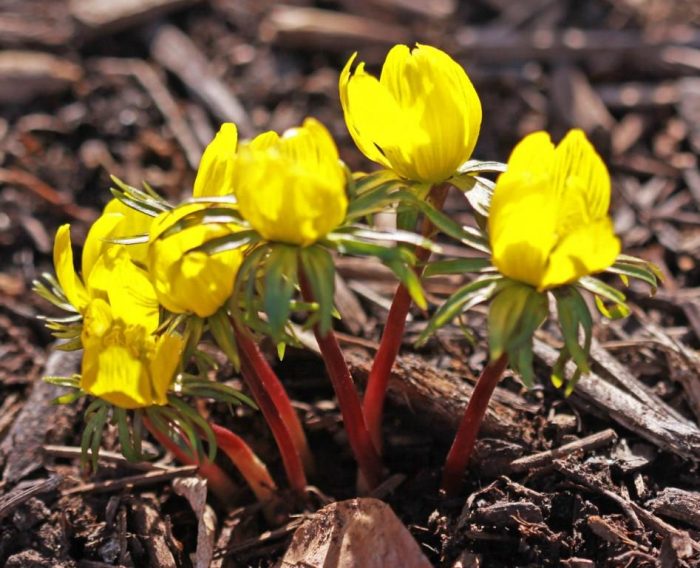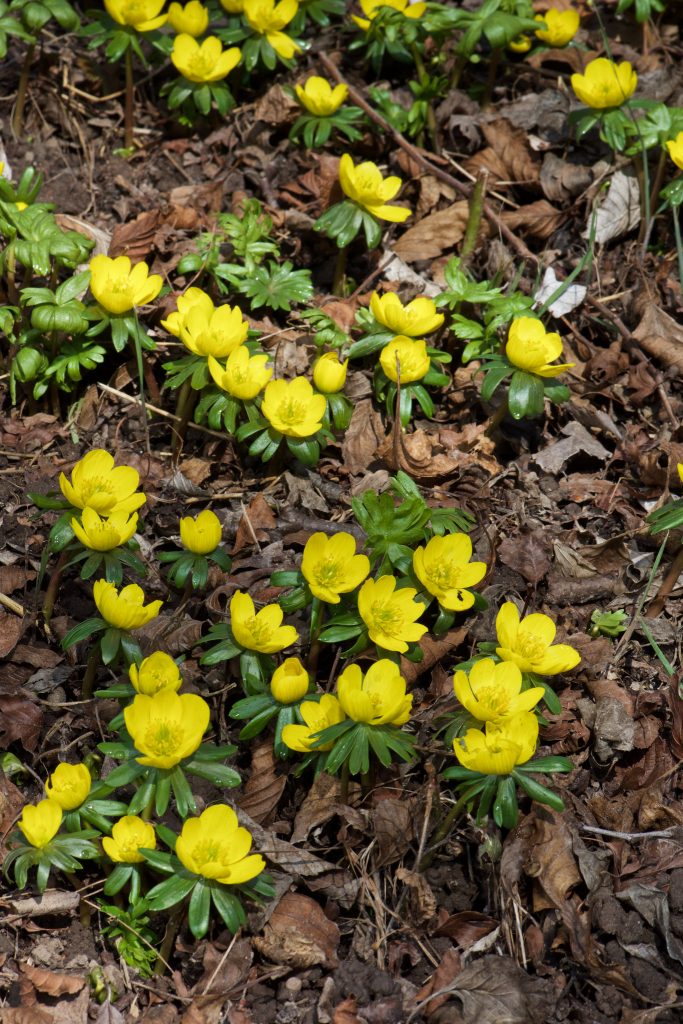Growing Winter Aconite – a Golden Treasure in your Garden
Growing winter aconite (Eranthis hyemalis) requires very little effort and brings tremendous rewards. Who can resist a bright, shiny yellow flower that adorns the garden when most of nature is still in deep sleep? Winter aconite has a reputation for being difficult to establish, but this can be addressed by giving it the right conditions. Follow the simple tips below to have the best possible chance of growing it successfully.
Basic facts
Winter aconite is a miniature perennial plant that grows only 10-15cm tall. It is often the first to flower in the garden, opening its blooms even earlier than snowdrops. In mild climate this happens already in January and in some areas aconites flower even before the snow melts.
The flowering continues for about two weeks. Only when it is over, leaves grow to their full size – like many other spring plants, aconite flowers before its leaves are fully developed. The leaves die off and disappear when seeds ripen in early summer.
Winter aconite is a native of Southern Europe, growing naturally in France, Spain and Italy. In the wild it forms amazingly beautiful yellow carpets on wood floor, while trees are still bare in early spring.
It has been cultivated as a decorative plant since the 16th century and continues to be popular today. It is beautiful, requires minimal care and is very easy to accommodate in the garden. Since it grows so early, it does not compete with other plants.
Where to plant winter aconites?
Winter aconite needs a site where it can get a lot of light while it grows and flowers – ideally it should be in the sun in January, February and March. In such conditions it will look its best.
This is because aconites open their flowers only in sunny weather. In cloudy weather, in the evening and at night their petals fold, covering the flower’s centre to protect it from moisture. The flowers therefore will not open fully in shade. They will also be much less prolific without sunlight.
Aconites can, however, happily grow under deciduous trees that have no leaves when they flowers. Aconites don’t mind being shaded by other plants later in the year, for this is what happens in woods where they grow naturally.

What soil do winter aconites require?
They require the soil that remains moist when they grow and does not get too dry or hot when they are dormant. These are again the conditions typical of woodland where they are found in the wild.
It is also extremely important that the soil is not waterlogged – aconites will rot and quickly die in such conditions. If the soil in your garden is prone to occasional waterlogging, it is best to plant them in raised beds.
Aconites prefer alkaline soil (pH above 7). They can grow in neutral, but not in acidic soil (рН below 5.5).
Aconites also like loose, crumbly and fertile soil that is rich in organic matter.
How to care for winter aconites
Aconites do not require any special care when they find themselves in the right conditions. As long as their rather distinctive requirements are met, they will flourish and spread year after year. So the aim is to provide the following:
- Soil that is not waterlogged.
- Soil that is moist during the period of growth, and is not too dry or hot during dormancy (as in woodland).
- Sun while aconites flower.
- Soil that is loose and rich in organic matter. To achieve this spread compost around plants in autumn or early winter before their growth starts. Organic mulch makes the soil richer, improves its texture and also helps to keep it moist in the summer.
Are winter aconites hardy?
They are hardy to -20C and do not require protection in winter. Flowers can appear before the snow is fully melted and are not afraid of frosts.

Growing winter aconites from bulbs
This is a common way of propagating aconites, but it needs to be done correctly. Their bulbs dry out very easily when out of the ground and die as a result. The best way of growing winter aconites therefore is to plant them ‘in the green’. This means that they should be lifted after flowering, but before the leaves die off, and replanted as soon as possible. It should be done very carefully, because aconites don’t like being disturbed.
Winter aconites ‘in the green’ can be ordered throughout spring from online suppliers, such as Peter Nyssen, in bulk (in 25s, 50s and 100s) and are not particularly expensive. They are advertised in online catalogues and gardening magazines.
How to plant winter aconites ‘in the green’?
Make planting holes about 10cm deep and at a distance of about 7-8cm from one another. Water the planting hole and add about 5cm of rotted organic matter, such as garden compost.
Ideally mix into compost some wood ash from deciduous trees (but not from conifers that will make the soil more acidic). This can be obtained from a bonfire, a fireplace or a wood burning stove. Wood ash acts as a fertiliser and at the same time helps to make the soil more alkaline. Put 2-3 plants in the hole, firm the ground around them and water.
Another way of introducing aconites into the garden is to buy them in pots as they are sold in garden centres in late winter and spring. They can be enjoyed on the patio and then planted in the garden after flowering, as described above, ‘in the green’ and with minimal disturbance. This is more expensive than buying them in bulk, but could be a good solution if you want a small amount to try first.

When should you plant winter aconite bulbs?
If you buy dry bulbs, it is best to do it as soon as possible after they go on sale in late summer and to plant them immediately after buying. Experience shows, however, that there are always some losses with this method, because the bulbs are fragile and dry out so easily.
There is a ‘secret’ that will improve the result: such bulbs should be soaked in water for 24 hours immediately before planting to re-hydrate them and increase their chances of survival.
Aconites ‘in the green’ are ordered from nurseries in spring and planted as soon as they arrive.
Which way up should winter aconite bulbs be planted?
It does not matter, the bulbs can be placed any way up.
How deep should you plant the bulbs?
The planting depth of aconite bulbs is 5cm. They should be spaced 6-7 cm from one another.
Can winter aconites be grown from seed?
Growing winter aconites from seed is certainly possible, and seeds are available for sale. Seeds should be planted outside, either immediately after they ripen in June or July, or in early autumn. They don’t remain viable for long, so it is best to use freshly collected seeds.
Plant them in relatively most soil, in light shade 1-1.5cm deep. The seedlings will soon appear, but will initially develop only round ‘seed leaves’, not ‘true’ highly divided leaves of mature aconites. The leaves will soon die off. This may look alarming, but the plants continue to grow and develop tubers in the soil during this period. True leaves will appear in spring. Young plants should be dug out before the leaves die off and transplanted to their permanent positions. They will flower in their 3rd year.

Are winter aconites invasive?
Given favourable conditions – fertile, reliably moist, alkaline soil and sun during the period of flowering – aconites will self-seed and spread. They can form large colonies on lawns and under trees.
Growing winter aconites in the garden
For maximum impact aconites are best planted in groups under trees, on edges of ponds, on lawns, and in perennial beds with fertile soil that does not dry out too much in the summer. They look absolutely beautiful combined with other early spring flowers, including snowdrops, early crocuses, irises, cyclamens and hellebores.

Varieties of aconites
Genus Eranthis includes several species and some are grown as decorative plants. Thus, Eranthis Сilicica is similar in appearance to the winter aconite, but has somewhat larger flowers and leaves that are bronze or almost purple when they first appear. Flower stalks continue to be reddish throughout.

Еranthis х tubergenii is a cross between winter aconite and Eranthis Сilicica. One of its cultivars is known as ‘Guinea Gold‘. It has larger, intensely yellow flowers, and a darker ‘collar’ than winter aconite.
Еranthis stellata is taller than other species (up to 20cm) and has white flowers.
Winter aconite (Eranthis hyemalis) is by far the most commonly grown species of the Eranthis genus, and the one most easily available commercially. Several different varieties of Eranthis hyemalis are cultivated, including:
- ‘Lady Lamortagne’ with large double flowers
- ‘Zitronenfalter’ and ‘Lightning’ with lemon-yellow flowers
- ‘Orange Glow’ with orange flowers
- ‘Gruenling’ with yellow flowers with green stripes
- ‘Pauline’ with light yellow flowers
- ‘Schwefelglanz’ with flowers that change colour from apricot at the beginning, to pale yellow as they mature.
Is winter aconite poisonous?
It is poisonous, like all members of the buttercup family (Ranunculaceae). When growing winter aconite, one therefore should be careful not to allow very young children to play with its flowers. On the positive side, however, since all their parts are poisonous, aconites are pest free!

Even in January it is possible to have colour in the garden due to plants that are not afraid of cold and snow. Winter aconite is a much loved messenger of spring that brings to our lives a promise of joy and beauty soon to come.
If you have experience of growing winter aconites, please share it in the comments.
Image credits: featured image – Eranthis hyemalis (Winter Aconite) by S. Rae
Related posts:
How to grow wild flowers in the garden
Hellebore – a Christmas Rose or a Lenten Rose? Detailed Growing Advice
Autumn crocus (Colchicum autumnale) – a Star of Early Autumn
How to protect plants from frost damage in spring
Pin ‘Growing Winter Aconite’ for later

